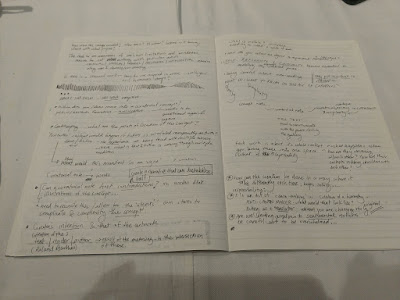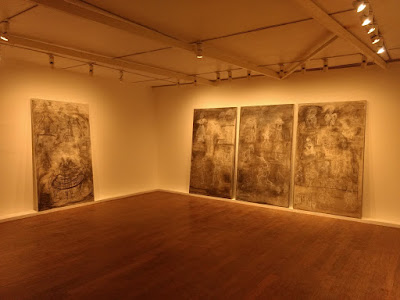
I spent the last two weeks of July 2018 at Khoj, Delhi as a fellow of the Curatorial Intensive South Asia program. Organized by Goethe Institut in collaboration with Khoj International Artists Association, the program aims at developing critical curatorial capacities within the South Asian region. The overall program is divided into two parts: a two week course on introduction to curatorial practice in South Asia, and an exhibition that the selected fellows put together individually in the latter part of the year. This year, six countries were represented at the program, with 12 participants. Six of us were from India, while remaining came from Pakistan, Nepal, Srilanka, Bangladesh and Iran. Over the two weeks, we had an intensive list of seminars on curatorship and art history within the region. The speakers included a range of curators, art historians, archivists and artists who spoke on different aspects of curatorial practice, exhibition making and art history.

The discussion opened in a thorough investigation of what constitutes the "contemporary" and what after all, is "curation"? How does one locate oneself in a larger framework? Leonhard Emmerling introduced us to System Theory - a concept which came from biology, developed in the '60s. The fundamental proposition of the theory is that humans are free, but bound to make choices. Emmerling explained to us how
...a system creates distinction or differentiation, in other words, a sense of distinct space. These spaces can be further, constantly differentiated, creating marked an unmarked "territories". The unmarked territories are not necessarily inactive, rather are contingent to claims. Further, a system works through communication (not on economy, wealth, etc.) Marked and unmarked areas create systems and subsystems. They communicate with each other through symbolically generalized media. Such symbolically generalized media could be love, art, truth, faith, power, etc. Art operates on the principle of aesthetic difference, which must be identified. Medium of art could be beauty. Aesthetic difference, however, is not beauty. The distinction between utility and beauty, is called by philosopher Jacques Ranciere, as the era of "as-if".
Such an elaborate discussion framed the overall course, where ideas and evaluation of art were put in an ideological framework. These were followed by sessions on exhibition history in the world, and the emergence of "curation" as a practice. Art historian Kavita Singh oriented us to the concept of museums as an entity that share the dual responsibilities of gathering of treasures on one hand, and the gathering of knowledge on the other. She explained, how, the institution of the museum works through the promise of taking ideas ahead for centuries together by amassing, and preserving or maintaining collections. Kavita Singh principally spoke of the colonial museum in India - it history, politics and problems.
Emmerling and Nancy Adajania later gave us a history of biennales across the world. They introduced us to art events with different periodicities (biennales, triennales or quick millenials). Adajania brought to our attention how a biennale is different from the museum or a gallery not only in its periodical occurrence, but also in the way it is mobilized. One cannot have a large scale event within a place without the State supporting it. Therefore, it is inevitably imbricated within the politics of the place it is located in. Adajania suggested through her historical tracing of art events how biennales have often hinged around, or began in a crisis of their place. She also indicated that an event like a biennale allows artists to rewrite the art historical canons. Political ruptures allow biennales to reframe their question(s), said Adajania. Within such evolution of biennales, the role of the curator comes to the centre after the 1990s, when, Nancy Adajania pointed, that the space of the critic is usurped by the curator and the collector. The curator then, is the new critic, and produces a space of "neo-criticality" that exists within the newly networked sphere of data aggregation and consumer experiences that emerged through the world wide web.

Alarming us of the high probability of curatorial desires coming to reality, Shuddhabrata Sengupta sensitized us to the responsibility of creating possibilities. He laid out for us further, a set of exhibition typologies that a curator may work with. While his idea-list was provisional, it helped us in thinking of curation in different dimensions of time and space. Some of his categories of exhibitions included a "generative or propositional type" which thinks of the event as a "future producing machine"; or "durational" where the curatorial intent is not exhausted by one event or exercise. Some others he spoke of were "epiphytic" where the resource is not really shared, but the work and space benefit each other; or "pedagogic exhibitions" which think of teaching itself as a curatorial process, that in which, students become collaborators in producing knowledge. Delineation of such strategies became extremely helpful for us to think of curatorial intents.

Our next few sessions were dedicated in looking at types of museums carefully. Leonard Emmerling helped us in delving deeper into the questions of ethnographic representation within museums. He brought us to think of methods of categorizing objects within a museum, which are inherently political. How does one relieve exhibits and displays that are embedded in hegemonic power structures? How do we address the question of an "ethnographic gaze" that gets constituted through museums, which eventually become instruments of self-imagination? We pursued the question of ethics of representing cultures and the mechanics of validation within the institution of a museum. Kavita Singh delivered an engaging lecture on 'Memorial Museums' where she pushed us to think if these were built for the past or the future? She provoked us to think if any such position like an "innocent bystander" was even possible?
Annapurna Garimella spoke on curating vernacular crafts within contemporary space. She spoke of the soft and strong ways in which curatorial processes intervene in the production of the vernacular. She argued that certain craft expressions were often tweaked in order to favour the aesthetic choices of the collectors. Curators became principal mediators of such shifting expressions. The vernacular, she indicated, has been an evolving tradition.

Curator and art historian Naman Ahuja brought to us the case study of his most recent, ambitious exhibition 'India and the World' which took historical objects lent from the British Museum, the National Museum (Delhi) and the Chhatrapati Shivaji Maharaj Vastu Sangrahalaya (Mumbai) to the venues in Mumbai and Delhi. In addition to the immense problem of the installation of the exhibition in Delhi (where about a dozen objects were eliminated), he shared numerous other aspects of translation, exhibition or display politics that render a curator as well as the curation in a complete alternate reading. On the other hand, Ahuja revealed a series of interconnections within the objects selected for 'India and the World' which compelled us to consider the multiple layers at which curation can work simultaneously.
Some of the questions that we discussed during the course with different speakers included the role and responsibility of curatorship in encouraging propositional thinking, engaging as well as subverting the demands of given agendas, avoiding giving into to the "gig" or even the "educational" economy. Natasha Ginwala opened the above questions to us, as she continued to provoke us to contemplate upon how mediation on issues can often become complicit within capitalistic flows, and how could it continue to wrestle with aspects of oversimplification or tropes that become populist in the social realm. All these questions were directed towards articulating South Asia as a critical geopolitical entity, and building new solidarities within the region.

Pooja Sood enthusiastically took us through Khoj's journey of organizing the '48 degrees' project in Delhi which was anchored around the three principal themes of 'Public - Art - Ecology'. Her presentation brought out the persistence of will, the agility of curation and the pursuit to influence. Radha Mahendru and Natasha Ginwala finally introduced us to community based art practices and provoked us to consider what it means to be "socially engaged". Radha gave us the embeddedness of Khoj within the community geographically as well as socially and further went on to articulate what it means for an art institution to be within in urban village like Khirkee. She took us through a gentle history of Khoj and its work, and their own learning about what does it mean to be socially engaged? Whom does socially engaged art cater to? Whom does it benefit, and how "engaged" one really is? These were questions that Khoj seemed to readdress through its endavours and new initiatives particularly the 'Khirkee Mahotsav'. Shuddhabrata Sengupta stepped in once again towards the end to discuss issues of censorship and the ethical limits of art. He shared with us case studies where bounds of censorship were creatively dealt with in order to be able to include certain artworks / artists within politically sensitive exhibition sites.
In the last section, Abhay Sardesai introduced us to the instrument of writing as thinking. He began by provoking us to think about the difference between an idea and a concept, and went on to open up the institutional apparatus. He explained how objects in an exhibition are often seen as illustrations of the concept note. However, Abhay suggested that objects must be seen as occasions that must complicate the reading of the concept note itself, rather than remaining mere illustrative. In setting up a dialogue between the curatorial note and the objects at display, the curator / writer may open up a productive space of thought. Abhay cautioned us against over-interpretation and urged us to work with in several modes: clarity and simplicity; clarity and complexity; contradiction and thickness of thought and lastly, consistency and rupture.
The concluding session of the course was an introduction to aspects of contracts, budgets and checklists for planning an exhibition. Pooja demythified the role of the curator from an intellectual head to someone who is responsible from start to end, including ideation, execution, fundraising, audience building and so on. She clarified that while the intellectual component of the exhibition may be enticing, it constitutes only 20% of the overall job. The remaining is coordination and getting the exhibition up for display. In the end, Vishal K Dar spoke of display and exhibition design strategies.
These were two weeks of intense learning and discussion. Apart from the above, the bonding sessions between the CISA fellows were fairly productive. Not only did we take time to discuss and help each other with our individual proposals, we shared notes from our own practices and places. The intercultural sharing is something that will now continue for a lifetime, and we look forward to participate in each others' exhibitions by the end of this year!























































